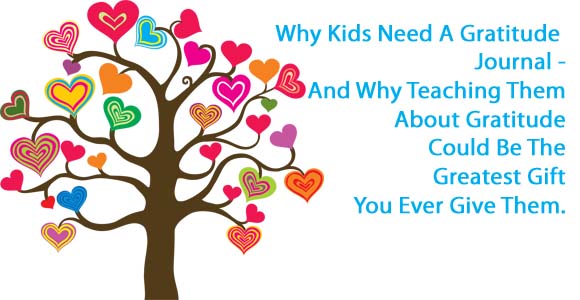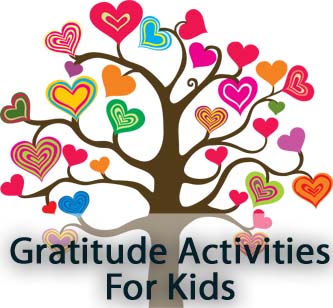I have to giggle when I feel drawn to discuss the idea of children and gratitude with parents. It gets a bit of a ‘Marmite’ response – the parents either love the idea or try to shoot me down in flames, telling me all the reasons why getting kids to feel grateful is either stupid or impossible!
Either way, it’s hard to argue against helping our kids to cultivate an ‘attitude of gratitude’ – surely it’s a great way to help them feel happier – and to grow up into more compassionate and grateful adults?

Here are 3 quick tips to help them love every moment of their gratitude journal experience.
A child’s gratitude journal is likely to be quite a different beast to one for adults. Last year I published Gratitude: A Daily Journal for ‘grown ups’ – and its fortnightly gratitude projects and affirmations are definitely aimed at those who are 16+. A gratitude journal for kids would be quite different.
For grown ups, gratitude usually needs to begin with the mind and then move to the heart, because decades of ‘life’ has often caused us to lock our hearts away, as a self-preservation measure.
But for kids, starting with the mind would mean that they would find it harder to connect with the wonderful heart-centred feeling that gratitude creates for them. So you dive in and let them get creative – opening their hearts and then their minds to gratitude.
And yet educators and psychologists are acknowledging the massive benefits that daily gratitude habits can have for children – for the rest of their lives. It’s amazing which life challenges can be overcome, if you have a strong foundation in connecting with the heart-centred feeling of ‘thank you’ – it opens the door to love, wonder and happiness.
Basically, helping your kids create a daily gratitude habit is one of the best gifts you can give them.
But how on earth do you help kids learn about gratitude?
Here are 3 insider secrets:
-
Let kids do gratitude their way!
The problem: We, as adults, usually think we know best. And it’s all too easy to forget how different the world of a child is, compared to ours. So we can end up trying to control how they ‘do’ gratitude – which will get in the way of them ‘being’ gratitude.
The solution:Children know, instinctively, what works for them. If it’s a gratitude jar – then great! If it’s a diary, great! If it’s telling a story – great! It’s not for us to dictate how they ‘should’ or ‘shouldn’t’ experience that sense of ‘thank you’.
Want some extra help? My kids love our Gratitude Diary For Kids.
You can find out more about it at the end of this article. -
Accept that lots of kids have ‘gratitude baggage’.
The problem:‘Thank you’ isn’t something that comes naturally to children, unless they have been regularly exposed to adults saying ‘thank you’ when they were tiny – and most of us forget that. Children mimic what is done around them, so a parent who oozes gratitude will say thank you much more than one who is stressed and exhausted.
Kids are often forced or bribed to say ‘thank you’, especially when they’re least in the mood. Remember those dreaded ‘thank you’ letters to Aunt Mabel, when she sent you embarrassing jumpers for Christmas? 🙂
It becomes something ‘required by society’, rather than a gift from the heart.
The solution: Allow for the fact that your kids might have ‘gratitude baggage’ and that ‘thank you’ might feel like a chore to them – if that’s what they have been brought up to feel.
Get creative – use words that resonate for them. Make up fun gratitude projects that inspire them.
Above all, encourage them to feel gratitude in whichever ways work for them.
 Want some extra inspiration? How about joining in with our 6 week online course – Gratitude Activities For Kids? It brings you an inspiring gratitude project each week, along with a members-only online forum where you can share the journey.
Want some extra inspiration? How about joining in with our 6 week online course – Gratitude Activities For Kids? It brings you an inspiring gratitude project each week, along with a members-only online forum where you can share the journey.
-
Do it yourself!
The problem: As I said earlier, children lean most easily (especially when they’re young) by mimicing the adults around them. It’s very much a case of “Do what I do, not what I say!”. So if you’re having issues, even at an unconscious level, with gratitude in your life, then that’s what your children will pick up. It’s amazing how well they read the unconscious signals we give out about what we believe about life. If you’re finding it hard to say ‘thank you’, then they will, too.
The solution: Sort out your gratitude issues! I strongly encourage you to dive in and start a gratitude journal – or even take a course. It only takes a few minutes a day and it could change your life forever.

 Want some extra inspiration? You could get yourself a copy of Gratitude: A Daily Journal – readers say they love the way it helps them to build a sustainable and life-inspiring gratitude habit, over the course of a year. Or, if you want to dive in and make progress fast, you could join our online course: Gratitude Kick Start today!
Want some extra inspiration? You could get yourself a copy of Gratitude: A Daily Journal – readers say they love the way it helps them to build a sustainable and life-inspiring gratitude habit, over the course of a year. Or, if you want to dive in and make progress fast, you could join our online course: Gratitude Kick Start today!
So there you have it – 3 insider secrets to help your kids love learning about gratitude.
I’d love to hear how you get on with these. Any insights? Any questions?
And do you have any suggestions you’d like to share with others? Please let us know, via the comments, below!
If you found this article useful, please share it with your friends!
Thank you. 🙂
Namaste,
![]()
P.S. Here’s the gratitude journal for kids that I mentioned in tip #1:

I love this! Having trouble finding a working link to the journal for kids…
Clare, what a wonderful idea! It makes total sense to start the practice young. I wish I was introduced to this notion when I was little and it would make all those years of life less likely to “lock our hearts away” as you say. When I have kids, I’m definitely going to introduce this idea. As an adult, however, it’s been difficult to move from the mind to the heart. I started using this site, thankaday.com, which has helped. I get little reminders to write something I am thankful for and sometimes I need to be reminded =)